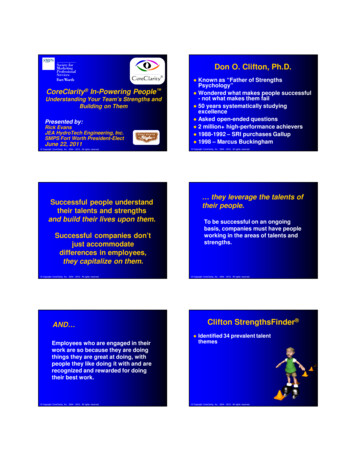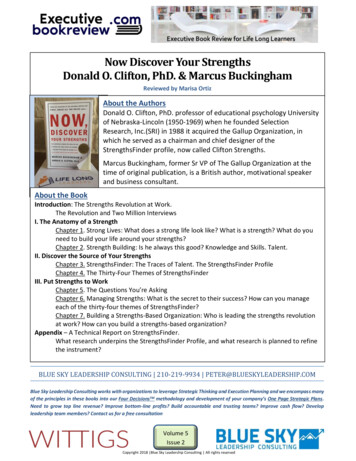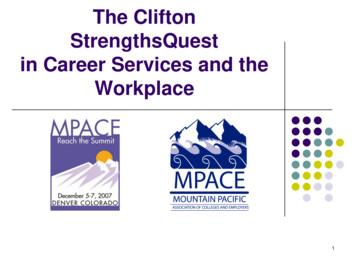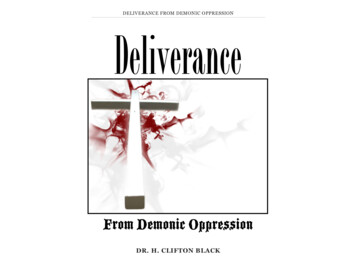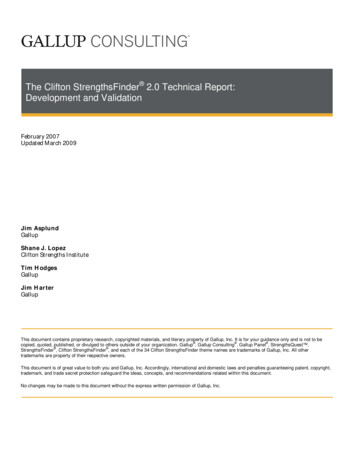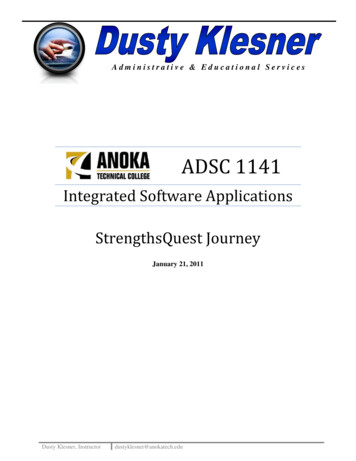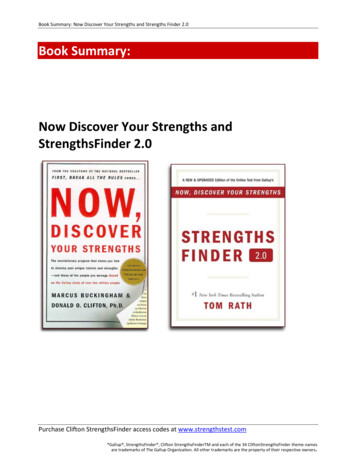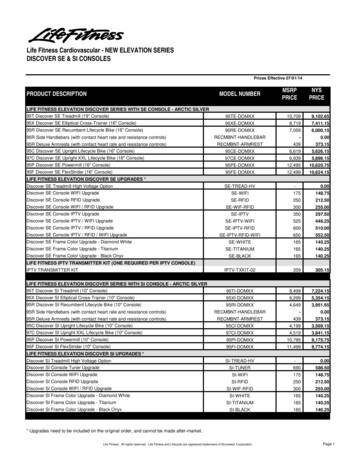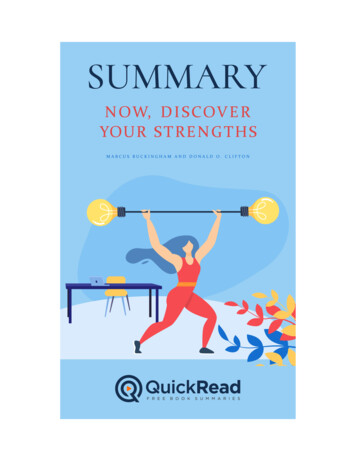
Transcription
Summary of “Now, DiscoverYour Strengths” by MarcusBuckingham and Donald O.CliftonWritten by Lea SchulleryLearn how to Develop Your Talents and Those of thePeople You Manage
Introduction5Why Correcting Our Weaknesses is All Wrong6Refine Your Talent with Knowledge and Skills8How Talents Are Developed10Observe Your Reactions to Uncover Hidden Talents12Utilizing Talents in the Workplace14Final Summary17
IntroductionWhile many of us are quick to identify our weaknesses and where we comeup short, we also have little sense of our talents and strengths. We fail torecognize which talents and skills we possess and how we can utilize themto work up to our full potential. This is likely because it is common practicefor companies and businesses to focus on areas of improvement. Now,researchers and management consultants Marcus Buckingham and DonaldO. Clifton have the answer to help you focus on boosting your strengths.Based on a Gallup study that interviewed over two million people who haveexcelled in their careers, Now, Discover Your Strengths uses arevolutionary program to help you discover your unique talents. Using theStrengthsFinder program, author Marcus Buckingham introduces thirtyfour talents or “themes” and reveals how best to utilize them to find successin both your career and personal life. Through the program, you’ll learnhow to discover your innate talents that might be hiding. You’ll also learnhow to identify the five dominant strengths that you can then develop andleverage to become your best, strongest self.
Why Correcting Our Weaknesses is AllWrongThroughout life, we are constantly encouraged to identify our weaknessesand improve upon them to become our best selves. According to MarcusBuckingham, this type of thinking is counterproductive. Instead, we shouldbe discovering our strengths to uncover a clear path to success. Before webegin, you’ll need to learn exactly what strength is. How do you know whatyour strengths even are?Well, strength is a “consistent near-perfect performance in an activity.” Inother words, it is any activity that you can perform repeatedly and excel intime and time again. And while you may be good at many different things, astrength must meet certain criteria. First, you must be able to do itconsistently. Tiger Woods, for example, is one of the best golfers in theworld because of his ability to consistently hit a golf ball off the tee and putton the green. Second, you don’t need strength in every aspect of your role toexcel. Tiger Woods is not necessarily the best chipper when compared toother pros who excel at chip shots. Instead, Woods focuses on his strength,his swing. Lastly, you will only excel by maximizing your strengths. Whilewe are constantly told to strengthen our weaknesses, we should insteadidentify them and learn how to manage or work around them.Organizations fail to understand this concept, however. Many organizationsdevelop programs that center on addressing the weaknesses of theiremployees; meanwhile, employees simultaneously feel as if their employersaren’t utilizing their full strength and talents. Unfortunately, organizationsonly make this issue worse by believing two things: 1) Anybody can acquirethe necessary knowledge and skills to be good at any job. 2) People developmost efficiently when their weaknesses are attacked. As a result, companieswaste time, money, and resources trying to fill their employees’ “skill gaps.”It should be no surprise then that the most successful organizations arethose who identify and develop the unique strengths of their employees.
A study developed by the Gallup Organization asked 198,000 employeesacross various businesses whether or not they believe they can do their bestat their job each day. The study revealed that only 20 percent ofrespondents agreed with the question. Of those 20 percent, thoseemployees were 50 percent more likely to work in an organization with lowemployee turnover, 38 percent more likely to work in a more productivebusiness, and 44 percent more likely to work for companies that had highcustomer satisfaction. Despite these statistics, organizations still attackweaknesses and often send employees to various trainings to correct them.Instead, companies work better if their employees grow and develop withthe organization. To accomplish this, companies will need to adopt adifferent approach to the way they do business.
Refine Your Talent with Knowledge andSkillsWhy is it that we always hear the phrase, “Practice makes perfect?” Inreality, this is not true! Instead, we have built up our strengths because wehave started with natural talent. So what is talent? Talents are simplypatterns of thoughts and behavior that make certain actions and jobs easierfor you. For example, some of us are naturally comfortable talking tostrangers. That’s a talent. Others fear to talk to others and try to avoidsocial situations. This ability or inability to talk to strangers is predisposed,we cannot change it.You can, however, take a predisposition that you like about yourself anddevelop it. This requires you to refine your talent with both knowledge andskills. Knowledge can be separated into two categories: factual knowledgeand experiential. Factual knowledge is gained through study and learning.This kind of knowledge is necessary for knowing what you need to perform.For example, an artist who wishes to create a powerful painting must firstknow how to mix paint!On the other hand, experiential is knowledge based on the lessons you learnthrough practice or trial and error. It’s more conceptual than factualknowledge, which means you must have some self-knowledge andawareness of your beliefs and values. For instance, salespeople may realizethey don’t enjoy persuading customers into buying something to turn aprofit. As a result, they may transfer into a role that meshes better withtheir innate talents, like human resources. When you break down yourexperiential knowledge into repeatable steps, you begin to engage in a skillbuilding activity. For instance, say you speak at several conferences. As youformalize your process for preparation, you practice by writing down storiesand telling them aloud. This process allows you to gain new skills andimprove your public speaking; however, if public speaking is not one ofyour innate talents, then you may never transform into an engaging public
speaker. At the end of the day, skills work best when they are combinedwith your innate talent.Our innate talents lie in our strongest synaptic connections. Improving ourweaker connections to make them equal to our stronger ones is nearlyimpossible. This is why when we focus on correcting our weaknesses, itbecomes a futile and frustrating experience. Links in the brain formthrough recurring patterns, and beyond a certain age, you are not going tobe able to “stitch a new design - your talents are enduring.” But whatexactly is a weakness anyway? A weakness is any lack that you have thatmay deter you from doing your best in any job or activity. Buckinghamsuggests that instead of attempting to overcome our weaknesses, we shouldsimply work around it. There are many ways to do this.First, you can attempt to get a little better at it. So while you can’tcompletely convert a weakness into a strength, you can certainly becomeproficient enough so that it doesn’t impact your performance. Tiger Woods,for instance, improved his chipping skills enough to win countlesstournaments. Second, you can design a support system. This meansdeveloping techniques that help you perform your best despite yourweakness. For example, incredibly disorganized people can rely on dailyplanners to keep them organized and on schedule. Third, use your strongestthemes to overwhelm your weakness. This simply means that if you have astrong passion or belief, then you can use that strength to overcome aweakness. For instance, people with a fear of public speaking can overcometheir fear if they have a passion for advocating a particular topic. Next, finda partner and team up with someone who has complementary strengths.Finally, just stop doing it. If your weaknesses are getting in the way, it’sokay to admit defeat. You can delegate the work, hire outside consultants,or even confess your weakness to your staff.
How Talents Are DevelopedSo now that we have learned what talent is, it’s time to take a look into thebrain to discover why some of us are naturally talented in some areas andnot others. In the brains of infants and young children, neuronscommunicate with one another through connections called “synapses.” Andup until the age of three, our brains contain a hundred billion neurons thatcan make roughly fifteen thousand connections between synapses. Theseconnections then allow brain cells to communicate with one another. Thebrain quickly creates links, thus forming patterns of threads andassociations. As you age, your synapse numbers steadily decrease until youreach the age of 15, then your mental network remains stable for the rest ofyour life.Losing billions of these connections is not necessarily a bad thing. When wehave fewer synaptic connections, we don’t suffer from sensory overload andwe can reinforce specific ones. As a result, some connections becomestronger than others, which explains how some of us can perform actionswith greater proficiency. As you know, certain movements, responses, andactivities come naturally to us while others feel uncomfortable. So if youwant to improve certain connections, you need to practice them and makethem strong enough to overcome the ones that cause you to behaveunfavorably.For instance, you may often practice staying calm in an argument. In theend, you might fail as your short-temper takes over and unleashes youranger. All that practice on keeping your cool is soon gone as yourunfavorable connections take control! The good news is that you canidentify your strengths and discover your talents by observing yourresponses to everyday situations. According to Buckingham, the simplesecret to success is “Capitalizing on your strengths and managing aroundyour weaknesses.” For instance, investment guru Warren Buffett attributeshis success to his ability to hone his talents and develop professional rolesthat played to his strengths. Buffett describes himself as both patient and
practical; therefore, he avoids “hot stocks” and invests in companies thatare more likely to give him long-term rewards. For example, he wasskeptical about investing in Microsoft at first because he was unsure of thestability and potential of the internet.
Observe Your Reactions to Uncover HiddenTalentsAs you look around the workplace, you’ll find that each person has his orher own unique strengths and talents. Unfortunately, many people fail toidentify them, thus their skills and strengths become wasted. But if wesimply observe our reactions to life’s problems and everyday encounters,then we can uncover our talents and use them to become our best selves.For instance, when an employee calls out sick, what is your first concern?Are you concerned with his or her health or the burden of unfinished work?It’s important to remember that neither reaction is right or wrong. Instead,these reactions simply show you your predominant skill. In the firstreaction, your strength is empathy; the second, your strength is the abilityto arrange and delegate work to ensure it all gets done. Or perhaps you areattending an event where you don’t know many people. Do you simply talkto the people you already know? If so, then your talent might be your abilityto foster and reinforce existing relationships. On the other hand, you mightthrive on meeting new people and immediately start talking to strangers. Ifthis sounds like you, then you likely have a talent for getting people to likeyou.When observing your instinctive reactions, there are two differentindicators for two kinds of talent: yearnings and rapid learning. Yearningsare those that reveal our talents early on in life. For example, Mozart wasjust twelve-years-old when he wrote his first symphony! What was yourinterest as a child? Perhaps looking at what you enjoyed in childhood canhelp you discover a hidden talent that you forgot about. On the other hand,rapid learning is observed when you try something new. How quickly areyou able to master it? If you can quickly master something new, thenperhaps you have a natural talent for something you didn’t know you had.For example, Henri Matisse didn’t begin painting until later in life where hebegan with a basic manual as a guide. Just four years later, he was acceptedinto Paris’s most prestigious art school.
Buckingham uses the StrengthsFinder program to help you identify thefive strongest themes of talent - your areas of greatest potential. Theprogram first builds upon your talents or your naturally recurring patternsof thought, feeling or behavior. Next, it helps you strengthen yourknowledge, or the facts and lessons you’ve acquired. Finally, it helps you toidentify your skills or the techniques of carrying out a particular process.You can begin to identify your own themes of talent in the next chapter.
Utilizing Talents in the WorkplaceOscar-winning director Sam Mendes attributes his success to his ability todirect each actor differently. By observing each actor, Mendes can create anenvironment that plays to each person’s strengths, allowing each actor to betheir absolute best. Managers should take a page from the book of Mendesand learn how to optimize their employees’ strengths. This method relies onthe “individualization” of each person’s unique talent. To discover thesetalents, Buckingham applies the StrengthsFinder Profile which helps you toidentify your five dominant themes or talent areas from a list of 34 possibletalents and characteristics. Your five strongest themes are the areas inwhich you’ll find your greatest growth potential. There are 33 millionpossible combinations, so finding someone with the exact profile and talentas you is incredibly rare.The following are common talents that you may find around the workplace: Achiever: for the achiever to feel fulfilled and satisfied, this personstrives to accomplish something every day.Arranger: This person is more logical and approaches complicatedprojects by analyzing its many aspects and organizing them intomanageable tasks.Belief: Believers value meaning more than money and excel at workthey find profound and fulfilling.Competition: This person acts as a contestant and compares his orher performance with others. They need competition to feel as ifthey’ve won. To them, winning is everything.Deliberative: A cautious individual weighs the risks before makingplans.Empathy: These individuals are incredibly warm and may notalways agree with others’ perspectives, but possess a unique ability torelate to other people’s feelings.
Harmony: This person creates a collaborative atmosphere byencouraging people to work together and abandon their personalagendas.Learner: These are the life-long students who enjoy the process oflearning as much as the result.Positivity: These people view the glass as always half-full andnaturally look at the bright side of life.Strategic: Strategists see patterns and identify routes to success incomplexityWoo: These convivial people enjoy engaging with strangers, meetingnew people and initiating conversations.Input: An inquisitive person who seeks out every bit of knowledgepossible.To utilize these talents around the workplace, you’ll need to identify anddetermine what type of job each talent enjoys and thrives in. For example,an Achiever needs responsibilities and goals to measure his or herperformance. An Arranger needs authority to oversee projects and organizea team. Perhaps you have a staff member that excels in Empathy, as amanager, you can use his or her strength to get inside the emotions of therest of the team members. Similarly, people who thrive on Input will enjoyprojects that require intensive research and collecting data from variouswebsites.By identifying each employees’ strengths, you can identify their talent andhelp them grow and develop. To do this, you can follow the formulaBuckingham recommends. First, select people properly in the first place.This means setting aside a budget and time to ensure you hire the bestcandidates. Next, set goals based on results. To do this, you’ll need to focuson performance by legislating outcomes instead of forcing people to followa single path. Now it’s time to build strength. Prioritize spending “trainingtime and money” to identify and improve each individual’s best strengths.Finally, beware of the destinations you develop for your employees. Insteadof simply moving people up the “corporate ladder” away from their
strengths, you should focus on encouraging each employee to build a solidcareer.
Final SummaryCompanies and organizations have it all wrong. They tell us to identify ourweaknesses and develop them to make us more well-rounded and performbetter. However, this type of workplace fails to utilize the strengths of theiremployees. Instead, we need to be identifying our strengths and working ondeveloping them to become the best version of ourselves. If you look insideyourself and observe the way you react to everyday situations, you’ll be ableto uncover some of your natural talents. Once you've identified your talents,you'll be able to develop the knowledge and skills necessary to bring thosepowerful strengths to light. Furthermore, organizations that understandhow to utilize the strengths of their employees will not only experiencegrowth in their people but growth in their organization. Such companieswill unleash new levels of success and develop strong teams that bring theirstrongest selves to work each and every day.
StrengthsFinder program, author Marcus Buckingham introduces thirty-four talents or “themes” and reveals how best to utilize them to find success in both your career and personal life. Through the program, you’ll learn how to discover yo
